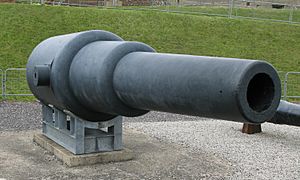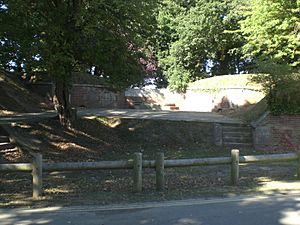Fortifications of the Isle of Wight facts for kids
The Isle of Wight is an island in southern England. For a long time, it has been a very important place for military protection. Many forts and strong buildings have been built there. These forts helped protect the island from attacks by other countries.
The Isle of Wight is important because it controls the entrances to the Solent. The Solent is a waterway that leads to Portsmouth, which is home to the Royal Navy, Britain's main navy. This article lists many of the forts and defenses found on the island.
Contents
Palmerston Forts: Protecting the Coast
The Palmerston Forts are a group of strong forts built a long time ago, during the Victorian era. This was when Queen Victoria was in charge of Britain. They are named after Lord Palmerston, who was the Prime Minister at the time. He strongly believed these forts were needed.
These forts were built because people in Britain were worried about a possible attack from France. The forts on the Isle of Wight were specifically made to guard the waterways leading to the Solent, Southampton, and Portsmouth. There are three main groups of these forts: some at the west end of the island, some at the east end, and four forts located right in the Solent water.
Bembridge Fort
Bembridge Fort is one of the Palmerston Forts. It was built on Bembridge Down. Its main job was to help protect the island from a possible French invasion.
Cliff End Battery
Cliff End Battery is another Palmerston Fort. It was built on the west coast of the island. Like the other Palmerston forts, it was made to defend against a feared attack from France.
Fort Albert
Fort Albert was built in 1856. It stands on an island made by people, not nature. This fort was designed to protect the western entrances to Portsmouth. It was planned to hold 29 guns on four different levels. Fort Albert was one of the last gun-towers built in England.
Fort Victoria
Fort Victoria was a defensive building with places for soldiers to live. It was built west of Yarmouth in the 1850s. Later, it was used as a place to control underwater mines. It also became a training area for the military.
The buildings where the soldiers lived were taken down in 1969. However, the strong, arched rooms called casemates were left. These casemates are all that remain of Fort Victoria today. You can now visit the fort as part of a country park.
Freshwater Redoubt
Freshwater Redoubt (also known as Fort Redoubt) is a Palmerston Fort. It was built on the west coast of the island, near Freshwater bay. Its purpose was to protect against the feared French invasion.
Nodes Point Battery
Nodes Point Battery is another Palmerston Fort. It was built on the east side of the island, at Nodes Point. It was part of the defenses against a possible French attack.
Puckpool Battery
Puckpool Battery was built at Puckpool Point on the east of the island. It is one of the Palmerston Forts. It was made to help protect the area from a feared French invasion.
Redcliff Battery
Redcliff Battery is a defensive structure located west of Culver Cliffs and east of Yaverland. It is one of the many Palmerston Forts. These forts were built to protect against a possible French invasion.
Sandown Battery
Sandown Barrack Battery is a defensive battery located in Sandown Bay. It is a Palmerston Fort built on the island. Its job was to protect against a feared French invasion.
Sandown Fort
Sandown Fort was built at Sandown, in the east of the island. It is one of the Palmerston Forts. It was made to protect against a feared French invasion.
Steynewood Battery
Steynewood Battery was built in the east of the island. It is one of the Palmerston Forts. It was made to protect against a feared French invasion.
Warden Point Battery
Warden Point Battery is a defensive structure on the Isle of Wight. Its construction started in 1862. It was first armed with large 7-inch and 9-inch guns. These guns were used until 1936.
Yarmouth Castle
Yarmouth Castle is a small, almost square fort built by King Henry VIII in 1547. Its job was to guard the harbour at Yarmouth, Isle of Wight. It was part of Henry VIII's plan to build a chain of coastal defenses. These forts were known as Device Forts or Henrician Castles. They were built to protect England from foreign attacks.
Because it was built later, Yarmouth Castle did not have the round shape of earlier forts. Instead, it had a square main tower, called a keep, with angled corners. Today, English Heritage owns and looks after Yarmouth Castle.
Yaverland Battery
Yaverland Battery was built in the east, at Yaverland. It is one of the Palmerston Forts. It was made to protect against a feared French invasion. During the Second World War, local volunteer soldiers called the Home Guard used it.



